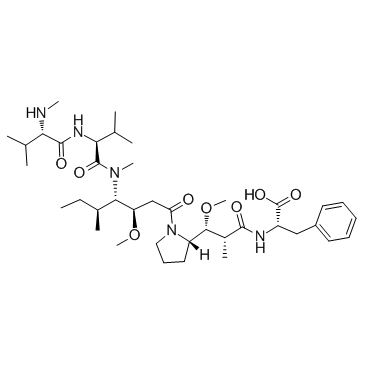| Description |
MMAF (Monomethylauristatin F) is an antitubulin agent that inhibit cell division; inhibits H3397 cell growth with an IC50 of 105 nM.
|
| Related Catalog |
|
| Target |
IC50: 119 nM (Cytotoxicity, Karpas 299 cell), 105 nM (Cytotoxicity, H3396 cell), 257 nM (Cytotoxicity, 786-O cell), 200 nM (Cytotoxicity, Caki-1, cell)[1]
|
| In Vitro |
MMAF (Monomethylauristatin F) shows in vitro cytotoxicity against a panel of cell lines. The IC50 values for Karpas 299, H3396, 786-O and Caki-1 are 119, 105, 257, and 200 nM, respectively. Targeted MMAF (Monomethylauristatin F) is much more potent than the free drug, and that cAC10 conjugates of MMAF (Monomethylauristatin F) display pronounced activities. On a molar basis, the cAC10-L1-MMAF4 is an average of over 2200-fold more potent than free MMAF (Monomethylauristatin F) and is active on all the CD30-positive cell lines tested[1].
|
| In Vivo |
The maximum tolerated dose in mice of MMAF (Monomethylauristatin F) (>16 mg/kg) is much higher than MMAF (Monomethylauristatin F) (1 mg/kg). cAC10-L1-MMAF4 has an MTD of 50 mg/kg in mice and 15 mg/kg in rats. The corresponding cAC10-L4-MMAF4 ADC was much less toxic, having MTDs in mice and rats of >150 mg/ kg and 90 mg/kg in rats, respectively[1].
|
| Cell Assay |
Cells are treated with serial dilutions of test molecules and incubated 4-6 days depending on cell line. Assessment of cellular growth and data reduction to generate IC50 values is done using Alamar Blue dye reduction assay[2].
|
| Animal Admin |
Mice: When subcutaneous Karpas 299 tumor size reaches 300 mm3, three animals per group receives one injection of 10 mg antibody component/kg body weight of either cAC10-L1-MMAF4 or cBR96-L1-MMAF4 intravenously. Tumors are then removed and placed in optimal cutting temperature compound, and 5 μm-thin frozen tissue sections are stained using immunohistochemistry evaluation[1].
|
| References |
[1]. Doronina SO, et al. Enhanced activity of monomethylauristatin F through monoclonal antibody delivery: effects of linker technology on efficacy and toxicity. Bioconjug Chem. 2006 Jan-Feb;17(1):114-24.
|
